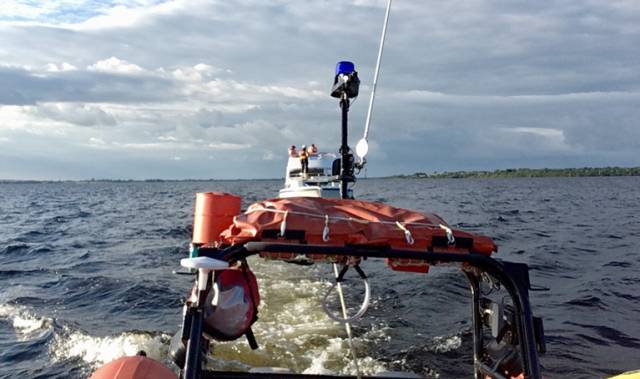On Saturday July 22, Valentia Coast Guard requested Lough Derg RNL to assist two people and their dog after their 38ft cruiser ran aground at Ryan’s Point, on the eastern shore of Lough Derg.
At 2.35pm the lifeboat was launched with helm Eleanor Hooker, Keith Brennan and Darragh Quinn on board. Winds were northeasterly, Force 2. Visibility was good.
Both passengers and their dog were found to be safe and unharmed and wearing their lifejackets. The RNLI made numerous attempts to take the cruiser off the rocks, but it was stuck fast. The RNLI volunteer crew decided to take both people and their dog to Dromineer and to arrange for the cruiser to be lifted off the rocks by a specialist crew from the local marina. They informed Valentia Coast Guard of their decision.
The lifeboat returned to station and was ready for service again at 4.32pm.
At 7.22pm, the lifeboat launched following a request from Valentia Coast Guard to assist four people in a 40ft cruiser with engine failure by the Goat Road, at the northern end of Lough Derg. At 7.40pm the lifeboat, with helm Eleanor Hooker, Owen Cavanagh and Kevin Dooley on board, located the cruiser adrift on the navigation route. The wind was northerly, F2/3.
The lifeboat took the vessel on an astern tow to Dromineer Bay, where the lifeboat volunteers changed the tow to an alongside tow before bringing the boat into Dromineer Harbour.
Once the cruiser was safely tied up alongside at Dromineer, the lifeboat returned to Station and was read for service again at 9.07pm
Brendan O’Brien, Deputy Launching Authority at Lough Derg RNLI Lifeboat Station, advises all boat users on the lake, to ‘bring charts of the lake in addition to electronic systems of navigation, and plan a safe passage before leaving harbour’.
 Lough Derg RNLI tow the cruiser
Lough Derg RNLI tow the cruiser

About The Author
Afloat.ie Team
Afloat.ie is Ireland's dedicated marine journalism team.
Have you got a story for our reporters? Email us here.
We've got a favour to ask
More people are reading Afloat.ie than ever thanks to the power of the internet but we're in stormy seas because advertising revenues across the media are falling fast. Unlike many news sites, we haven’t put up a paywall because we want to keep our marine journalism open.
Afloat.ie is Ireland's only full–time marine journalism team and it takes time, money and hard work to produce our content.
So you can see why we need to ask for your help.
If everyone chipped in, we can enhance our coverage and our future would be more secure. You can help us through a small donation. Thank you.






























































